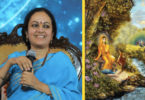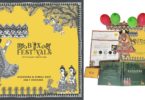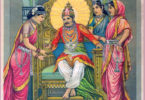Ma Kushmanda – The Goddess Worshipped on the Fourth Day of Navratri
Ma Kushmanda is worshipped by devotees on the fourth day of Navratri. This avatar of Adi Shakti is also referred to as the Smiling Goddess. Her name is made up of three distinct words. The first word is “Ku” which means little. The second word is “Ushma” which means warmth or energy. And the third word is “Anda” which means egg. Upon combining the three words, one can derive the meaning of her name which means the one who is the creator of this “little cosmic egg” called Universe. This form is a happy manifestation of the goddess.
It is said that when the universe was non-existent and there was darkness everywhere, Ma Kushmanda produced this “little cosmic egg” with her smile. The universe was then filled with light. It is believed that she is the source of all the energy in the universe. Further, it is also believed that she lives in the core of the Sun and thus provides energy to all the beings. She is believed to provide direction to Surya, the Sun God.
Ma Skandamata: The Goddess Worshipped on the Fifth Day of Navratri
Ma Skandamata is the fifth avatar of Durga and is worshipped on the fifth day of Navratri. Skanda is another name for Lord Kartikeya (Parvati’s son and Lord Ganesha’s brother). Mata means mother and thus Skandamata means mother of Skanda or Kartikeya. As is clear from the name, she is another form of Parvati.
The birth of Kartikeya is an interesting story. After Sati immolated herself, Shiva became detached from the worldly affairs and started practicing austere penance as an ascetic. At the same time, the gods (devas) were under an attack from demons (asuras) who were being led by Surapadman and Tarakasura. They had a boon that only Shiva or his offspring could kill them.
Ma Katyayani: The Goddess Worshiped on the Sixth Day of Navratri
Ma Katyayani is worshipped on the sixth day of Navratri. She has four hands and she wields a long sword and a lotus in two of them. She blesses with the third hand and protects with the fourth one.
According to the legends, there was a sage known as ‘Kat’ who had a son named ‘Katya’. Later, a sage named ‘Katyayan’ took birth as his descendant. Sage Katyayan had no offspring. He observed austere penance and prayed to the gods for a child.
Meanwhile, the demon Mahishasura was creating a lot of trouble for the gods. The gods approached Vishnu to sought a way to end Mahishasura. At Vishnu’s behest, Shiva and Brahma joined him and then the Trinity (Vishnu, Shiva and Brahma) emitted flames which took the form of Katyayani. A manifestation of Durga, she then took birth as the daughter of Sage Katyayan as a result of which she came to be known as Katyayani.
Ma Kaalratri: The Goddess Worshipped on the Seventh Day of Navratri
Ma Kaalratri is the goddess who is worshiped on the seventh day of Navratri. Kaal refers to time as well as death in Hindi whereas ratri refers to night or darkness/ignorance. Hence, Ma Kaalratri is the one which brings the death of darkness or the one who ends ignorance. She is also commonly referred as Kali.
Once two demons named Shumbha and Nishumbha invaded devaloka and defeated Indra and his army. After losing his kingdom, Swarga, Indra along with all the other gods went towards the Himalayas to seek help. They prayed to goddess Parvati and sought her assistance in getting their kingdom back. Parvati created Chandi and sent her to kill the demons. In the battlefield, Shumbha and Nishumbha sent two demons Chanda and Munda. Chandi created another goddess, Kali, to fight Chanda-Munda. Kali killed both of them and thus came to be known as Chamunda.
Read more Stories About Kali here.
Ma Mahagauri: The Goddess Worshipped On The Eighth Day of Navratri
Mahagauri is the Goddess worshiped on the eighth day of the 9-day long festival of Navratri in India. Maha means extremely and gauri means white. She is worshiped by devotees to attain loyalty in relationships and create life-long bonds.
The story of Mahagauri has many versions. The most popular is this. After killing all demons in the form of Kaalratri, Parvati was left with skin as dark as night. Her husband Shiva teased her with the nickname ‘Kali’ (dark-skinned). Agitated, Parvati applied to Brahma by undergoing a severe penance lasting many days, to regain her fair skin. Pleased, Brahma advised her to take a bath in the Mansarovar River in the Himalayas (some local variants replace the Mansarovar River with the holy Ganges river).





Hi Cannot see the 9th Day of Navratri story. Please help with the same. Thanks
Thank you so much for this story ….very great explination